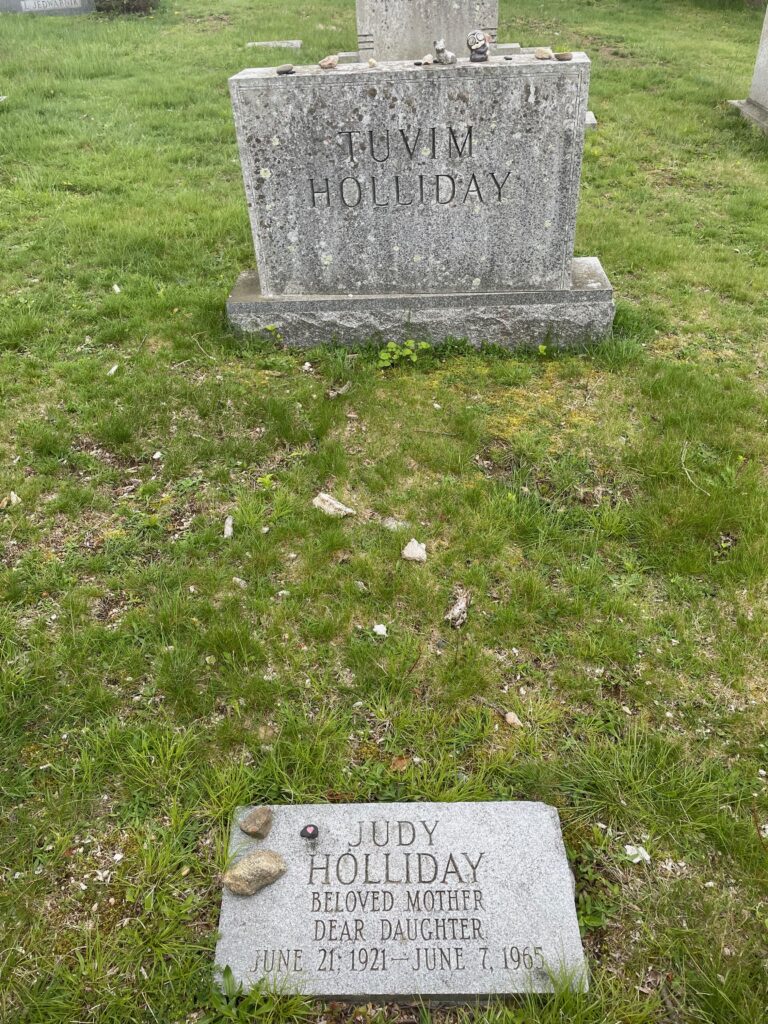Erik Visits an American Grave, Part 1,391
This is the grave of Judy Holliday.

Born in 1921 in Queens, Judith Tuvim grew up in the immigrant dominated Jewish neighborhoods of New York. These were politically radical people and she grew up to be quite the radical herself. Her father was a long time Socialist Party candidate for the New York legislature and later ran the Jewish National Fund of America. Adopting the last name Holliday for a stage career, she became active in theater almost immediately as a young woman. She graduated from high school in 1938 and got a job working for Orson Welles and John Houseman at the Mercury Theater in New York as a switchboard operator. Wasn’t much of a job, but it put her around major figures in the theater.
That same year, Holliday started acting in a nightclub act called The Revuers, which had several people in it who were later moderately successful figures in American life, though none more so than Holliday. Well, except for Leonard Bernstein, who sometimes played the piano for the act. She suffered from stage fright early in her career and frequently vomited before shows, though she got over that. The group filmed a scene for Greenwich Village, a Carmen Miranda vehicle that came out in 1944. The scene was cut, but the people making the movie became interested in Holliday’s potential. Her buddy Bernstein certainly didn’t hurt her credibility. The Revuers broke up soon after and Holliday started a successful solo career.
Mostly, Holliday worked on Broadway. She won the Derwent Award for Most Promising Female Actress for her work in 1945’s Kiss Them for Me. When Jean Arthur turned down the lead in Garson Kanin’s Born Yesterday in 1946, he went with Holliday instead. She was a big hit.
But Holliday did appear on the silver screen too. Her first role was in Winged Victory in 1944, one of those ham-fisted pro-war movies that appeared all the time during the war, though to be fair here, it was directed by George Cukor so it was much better than most. When Columbia bought the rights to Born Yesterday to turn it into a film, Harry Cohn was opposed to Holliday playing the lead, since no one outside of the New York theater scene knew who she was. She had real allies though, including Cary Grant and Katharine Hepburn, not to mention Cukor. With Hepburn and Cukor working together on Adam’s Rib, they conspired to give Holliday a big role so that Cohn would give her the lead in Born Yesterday. It worked, though Cohn grumbled the whole time. Ah, the studio system.
Well, it worked out. Holliday won Best Actress at the Academy Awards, defeating Gloria Swanson in Sunset Boulevard, for god’s sake. I’ve never seen Born Yesterday, so I can’t speak to it, but Swanson was pretty great so it’s hard for me not to be a bit sad about that. But good for Holliday either way.
While Holliday would have a few more films, her career ran into the buzzsaw of McCarthyism. Holliday remained a radical to the end of her life, with no apologies. She was a big supporter of Henry Wallace in 1948, though she was willing to compromise to support Adlai Stevenson in 1952. When she was called to testify for the loathsome McCarran Committee investigating Hollywood communists for the Senate, she went back to her acting world to play a role where she would denounce Stalinism but support anyone who wanted to be communist, all while trying to play the ditz. She was a bit embarrassed by this, but you do what you have to do. And better to act than to lower yourself to these scumbag politicians. She was proud that she never named names.
Although Holliday was more or less derailed for a couple of years due to the investigations, she was working consistently again in the late 50s. She tended to work more on Broadway than film at this time, I assume in part because the roles were better and in part to avoid the asshole politicians. She won the Tony in 1957 for Best Leading Actress for her part in Bells Are Ringing. She eventually did go back to Hollywood for the 1960 film version of this, which Vincente Minnelli directed and Dean Martin also starred in.
Holliday’s personal life was a bit tumultuous. She married the clarinetist and television producer David Oppenheimer in 1948. They were long-time friends, but he was in the closet. Sort of anyway. Everyone around him knew he was gay in fact Bernstein suggested he marry Holliday as a beard. She was cool with that. They even had a child. They finally divorced in 1957. But her real love was the saxophonist Gerry Mulligan. He was addicted to heroin, of course, so I assume she at least dabbled in it too, but this is conjecture on my part. They never married but lived together until the end of her life. They recorded an album together with his band and her singing in 1961. She got him roles in some of her films. Very sadly though, Holliday developed breast cancer and this killed her in 1965. She was 43 years old.
Let’s watch some of Holliday’s work.
Judy Holliday is buried in Westchester Hills Cemetery, Hastings-on-Hudson, New York.
If you would like this series to visit other Best Actress winners, you can donate to cover the required expenses here. Shirley Booth, who won in 1952 for Come Back, Little Sheba, is in Montclair, New Jersey and Susan Hayward, who won in 1958 for I Want to Live! is in Carrollton, Georgia. Previous posts in this series are archived here and here.


